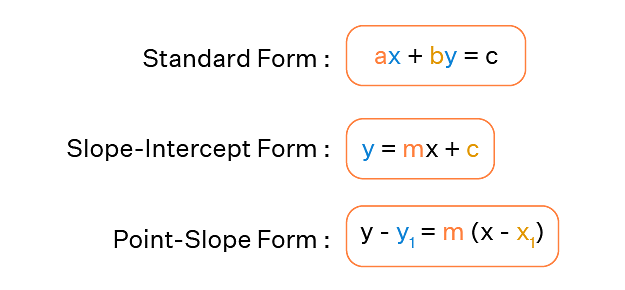Find the coordinates of the foot of perpendicular from the point \( (–1, 3) \) to the line \(3x – 4y – 16 = 0.\)
Solution and Explanation
Let (a, b) be the coordinates of the foot of the perpendicular from the point (-1, 3) to the line \(3x - 4y - 16 = 0.\)

Slope of the line joining (-1, 3) and (a, b), \(m_1=\frac{b-3}{a+1}\)
Slope of the line \(3x - 4y - 16 = 0\) or \( y=\frac{3}{4}x-4\) , \(m_2 =\frac{ 3}{4}\)
Since these two lines are perpendicular, \(m_1m_2 = -1\)
\(∴\frac{(b-3)}{(a+1)} \times (\frac{3}{4}) = -1\)
\(⇒\frac{\left(3b-9\right)}{\left(4a+4\right)} = -1\)
\(⇒3b–9=-4a – 4\)
\(⇒4a+3b=5 …….(1)\)
Point \((a, b)\) lies on line \(3x - 4y = 16.\)
\(∴3a - 4b = 16 … (2) \)
On solving equations (1) and (2), we obtain
\(a = \frac{68}{25} \) and \(b = \frac{-49}{25}\)
Thus, the required coordinates of the foot of the perpendicular are\( \left(\frac{68}{25},\frac{ -49}{25}\right)\)
Top Questions on Distance of a Point From a Line
- Find the point on the line \( \frac{x-1}{3} = \frac{y+1}{2} = \frac{z-4}{3} \) at a distance of \( \sqrt{2} \) units from the point \( (-1, -1, 2) \).
- CBSE CLASS XII - 2025
- Mathematics
- Distance of a Point From a Line
- If a point $ P(x, y) $ satisfies the condition that its distance from the point $ (3, -2) $ is equal to its distance from the line $ y = 2x + 1 $, then the locus of point $ P $ is:
- BITSAT - 2025
- Mathematics
- Distance of a Point From a Line
- Find the foot of the perpendicular drawn from the point \( (1, 1, 4) \) on the line \( \frac{x+2}{5} = \frac{y+1}{2} = \frac{z-4}{-3} \).
- CBSE CLASS XII - 2025
- Mathematics
- Distance of a Point From a Line
- Find the point on the line \( \frac{x-1}{3} = \frac{y+1}{2} = \frac{z-4}{3} \) at a distance of \( \sqrt{2} \) units from the point \( (-1, -1, 2) \).
- CBSE CLASS XII - 2025
- Mathematics
- Distance of a Point From a Line
- Find the midpoint of the line segment joining the points (3, 4) and (7, -2).
- AP EAPCET - 2025
- Mathematics
- Distance of a Point From a Line
Questions Asked in CBSE Class XI exam
- \(\text{tan x}=-\frac{4}{3},\text{x\, in\, quadrant \,II.}\)
- CBSE Class XI
- Trigonometric Functions of Sum and Difference of Two Angles
- If the function f(x) satisfies \(\lim_{x\rightarrow 1}\) \(\frac{f(x)-2}{x^2-1}\) =\(\pi\), evaluate \(\lim_{x\rightarrow 1}\) f(x).
- \(∆U^Θ\) of combustion of methane is – \(X\ kJ \ mol^{–1}\). The value of \(∆H^Θ\) is
- CBSE Class XI
- Thermodynamics terms
- Write the resonance structures for SO3 , NO2 and NO3-
- CBSE Class XI
- Kossel-Lewis Approach to Chemical Bonding
- Three reasons why the author’s grandmother was disturbed when he started going to the city school.
- CBSE Class XI
- The Portrait of a lady
Concepts Used:
Straight lines
A straight line is a line having the shortest distance between two points.
A straight line can be represented as an equation in various forms, as show in the image below:

The following are the many forms of the equation of the line that are presented in straight line-
1. Slope – Point Form
Assume P0(x0, y0) is a fixed point on a non-vertical line L with m as its slope. If P (x, y) is an arbitrary point on L, then the point (x, y) lies on the line with slope m through the fixed point (x0, y0) if and only if its coordinates fulfil the equation below.
y – y0 = m (x – x0)
2. Two – Point Form
Let's look at the line. L crosses between two places. P1(x1, y1) and P2(x2, y2) are general points on L, while P (x, y) is a general point on L. As a result, the three points P1, P2, and P are collinear, and it becomes
The slope of P2P = The slope of P1P2 , i.e.
\(\frac{y-y_1}{x-x_1} = \frac{y_2-y_1}{x_2-x_1}\)
Hence, the equation becomes:
y - y1 =\( \frac{y_2-y_1}{x_2-x_1} (x-x1)\)
3. Slope-Intercept Form
Assume that a line L with slope m intersects the y-axis at a distance c from the origin, and that the distance c is referred to as the line L's y-intercept. As a result, the coordinates of the spot on the y-axis where the line intersects are (0, c). As a result, the slope of the line L is m, and it passes through a fixed point (0, c). The equation of the line L thus obtained from the slope – point form is given by
y – c =m( x - 0 )
As a result, the point (x, y) on the line with slope m and y-intercept c lies on the line, if and only if
y = m x +c